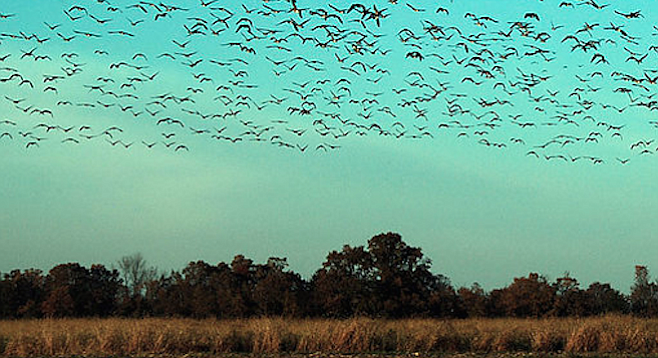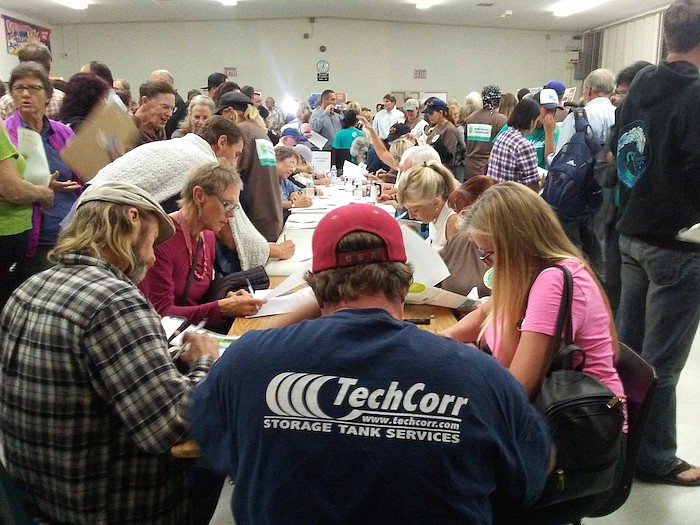 Facebook
Facebook
 X
X
 Instagram
Instagram
 TikTok
TikTok
 Youtube
Youtube

More than 300 people packed the Mission Bay High School auditorium Monday night (November 7) to get a look at the city's three alternative plans for De Anza Cove. Few attendees left happy.
Groups of Campland supporters — many of whom came to the event on buses provided by the resort — worried that Campland would not be allowed to remain, while dozens of members of ReWild (in blue T-shirts) worried that there wouldn't be enough land set aside for habitat restoration.

Ninety-two-year-old Karen Yount worried about her swim club that uses De Anza Cove. "It's the most popular place to swim in Mission Bay because it's shallow and the water is warmer," Yount said. "We've been swimming there for 60 years — for us it's very important to preserve. You know there will be more seniors when your generation gets older who want a nice place to swim."
The three scenarios take the collection of wishes expressed by people at the June planning meeting and move them around like puzzle pieces on the 166 acres of land that used to be a mobile-home park. Tennis courts, walkways, a golf course, non-motorized boat rentals, picnic areas, a restaurant, and what was called "guest housing" all were shuffled around and given different priority — expressed by land. For example, the "guest housing" garnered between 27 acres and 40 acres, which is Campland's current size.
"I like the idea that they have guest housing, but it's totally open for who will own and run it," said Sherry Murphy. "Campland is unique in the whole country. To wipe it off and put it up for grabs, that's not right."
But environmentalists, including ReWild and the Audubon Society, have different priorities for the land.
"This is just the recommercialization by lodging and restaurants of De Anza," said Scott Andrews. "When I hear clusters of restaurants, that's all I can think." Megan Flaherty of the Audubon Society was dismissive of the 100-foot-wide swaths of land for wildlife. "This isn't just about a ball field for your kidsl it's a once-in-a-lifetime opportunity to restore what we lost — the wetlands that disappeared. It's the largest potential wetlands in California," Flaherty said. "It's an opportunity to fix what was broken."
Two of the scenarios envision carving chunks of the southeast corner into islands accessible by footbridges. The city facilitators said they don't have firm plans yet — they are looking for community input, and they got a lot of it. There's more opportunity to comment on the website, where the city will be accepting comments until Nov. 30, then refining the ideas and returning to the public.
"The city doesn't pick winners and losers. The city doesn't like winners and losers as a scenario," said Lewis Michaelson of the project team. "This is a three-year process and we are entering the second phase."
Comments and drawings are at DeAnzaRevitalizationPlan.com.


More than 300 people packed the Mission Bay High School auditorium Monday night (November 7) to get a look at the city's three alternative plans for De Anza Cove. Few attendees left happy.
Groups of Campland supporters — many of whom came to the event on buses provided by the resort — worried that Campland would not be allowed to remain, while dozens of members of ReWild (in blue T-shirts) worried that there wouldn't be enough land set aside for habitat restoration.

Ninety-two-year-old Karen Yount worried about her swim club that uses De Anza Cove. "It's the most popular place to swim in Mission Bay because it's shallow and the water is warmer," Yount said. "We've been swimming there for 60 years — for us it's very important to preserve. You know there will be more seniors when your generation gets older who want a nice place to swim."
The three scenarios take the collection of wishes expressed by people at the June planning meeting and move them around like puzzle pieces on the 166 acres of land that used to be a mobile-home park. Tennis courts, walkways, a golf course, non-motorized boat rentals, picnic areas, a restaurant, and what was called "guest housing" all were shuffled around and given different priority — expressed by land. For example, the "guest housing" garnered between 27 acres and 40 acres, which is Campland's current size.
"I like the idea that they have guest housing, but it's totally open for who will own and run it," said Sherry Murphy. "Campland is unique in the whole country. To wipe it off and put it up for grabs, that's not right."
But environmentalists, including ReWild and the Audubon Society, have different priorities for the land.
"This is just the recommercialization by lodging and restaurants of De Anza," said Scott Andrews. "When I hear clusters of restaurants, that's all I can think." Megan Flaherty of the Audubon Society was dismissive of the 100-foot-wide swaths of land for wildlife. "This isn't just about a ball field for your kidsl it's a once-in-a-lifetime opportunity to restore what we lost — the wetlands that disappeared. It's the largest potential wetlands in California," Flaherty said. "It's an opportunity to fix what was broken."
Two of the scenarios envision carving chunks of the southeast corner into islands accessible by footbridges. The city facilitators said they don't have firm plans yet — they are looking for community input, and they got a lot of it. There's more opportunity to comment on the website, where the city will be accepting comments until Nov. 30, then refining the ideas and returning to the public.
"The city doesn't pick winners and losers. The city doesn't like winners and losers as a scenario," said Lewis Michaelson of the project team. "This is a three-year process and we are entering the second phase."
Comments and drawings are at DeAnzaRevitalizationPlan.com.
Comments